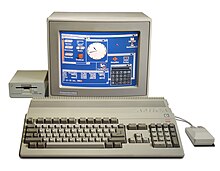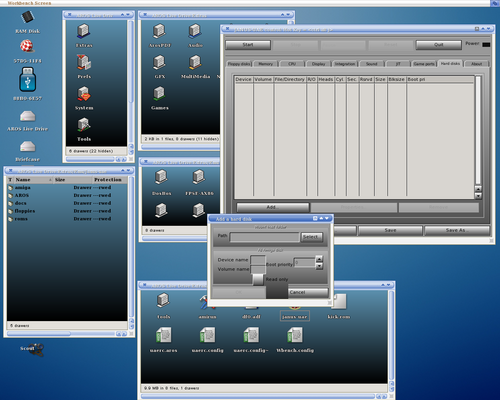Portal:Amiga
The Amiga Portal

Amiga is a family of personal computers introduced by Commodore in 1985. The original model is one of a number of mid-1980s computers with 16- or 16/32-bit processors, 256 KB or more of RAM, mouse-based GUIs, and significantly improved graphics and audio compared to previous 8-bit systems. These systems include the Atari ST—released earlier the same year—as well as the Macintosh and Acorn Archimedes. Based on the Motorola 68000 microprocessor, the Amiga differs from its contemporaries through the inclusion of custom hardware to accelerate graphics and sound, including sprites and a blitter, and a pre-emptive multitasking operating system called AmigaOS.
The Amiga 1000 was released in July 1985, but production problems kept it from becoming widely available until early 1986. The best-selling model, the Amiga 500, was introduced in 1987 along with the more expandable Amiga 2000. The Amiga 3000 was introduced in 1990, followed by the Amiga 500 Plus, and Amiga 600 in March 1992. Finally, the Amiga 1200 and Amiga 4000 were released in late 1992. The Amiga line sold an estimated 4.85 million units.
Although early advertisements cast the computer as an all-purpose business machine, especially when outfitted with the Sidecar IBM PC compatibility add-on, the Amiga was most commercially successful as a home computer, with a wide range of games and creative software. It also found a niche in video production with the Video Toaster hardware and software, and Amiga's audio hardware made it a popular platform for music tracker software. The processor and memory capacity enabled 3D rendering packages, including LightWave 3D, Imagine, and Traces, a predecessor to Blender.
Poor marketing and the failure of later models to repeat the technological advances of the first systems resulted in Commodore quickly losing market share to the rapidly dropping prices of IBM PC compatibles, which gained 256 color graphics in 1987, as well as the fourth generation of video game consoles.
Commodore ultimately went bankrupt in April 1994 after a version of the Amiga packaged as a game console, the Amiga CD32, failed in the marketplace. Since the demise of Commodore, various groups have marketed successors to the original Amiga line, including Genesi, Eyetech, ACube Systems Srl and A-EON Technology. AmigaOS has influenced replacements, clones, and compatible systems such as MorphOS and AROS. Currently Belgian company Hyperion Entertainment maintains and develops AmigaOS 4, which is an official and direct descendant of AmigaOS 3.1 – the last system made by Commodore for the original Amiga Computers. (Full article...)
Selected article
Aminet is the world's largest archive of Amiga-related software and files. Aminet was originally hosted by several universities' FTP sites, and is now available on CD-ROM and on the web. According to Aminet, as of 1 April 2013, it has 80592 packages online.
In January, 1992 Swiss student Urban Müller took over a software archive that had been started by other members of a computer science students' club. Soon the archive became mirrored worldwide and in 1995 started being distributed on monthly CD-ROMs. Reports of daily additions to this software archive were posted automatically to Usenet (de.comp.sys.amiga.archive), or could be requested as an email newsletter. Most of the programs on Aminet were public domain or shareware, but software companies made updates and demo versions of their programs available as well. Now Aminet is complemented by platform specific sites archiving software for AmigaOS 4, AROS or MorphOS only. (Full article...)
Selected biography
Gillen has worked for publications such as PC Gamer UK, The Escapist, Amiga Power (under the pseudonym "C-Monster"), Wired, The Guardian, Edge, Games Developer, Develop, MCV, GamesMaster and PC Format, among others. (Full article...)
Categories
Topics

- .info
- 8SVX
- Action Replay
- ACube Systems Srl
- AHI
- Amazing Computing
- Amiga 500
- Amiga 500 Plus
- Amiga 600
- Amiga 1000
- Amiga 1200
- Amiga 2000
- Amiga 3000
- Amiga 3000T
- Amiga 3000UX
- Amiga 4000
- Amiga 4000T
- AmigaOne
- AmigaOne X1000
- AmigaOS
- AmigaOS versions
- AmigaOS 4
- AmigaOS 4 versions
- Amiga A570
- Amiga Action
- Amiga Active
- Amiga Addict
- AAA
- AGA
- Amiga CD32
- Amiga Chip RAM
- Amiga Computing
- Amiga Corporation
- Amiga custom chips
- Amiga demos
- Amiga Disk File
- Amiga Enhanced Chip Set
- Amiga Fast File System
- Amiga Forever
- Amiga Halfbrite mode
- Amiga Hunk
- Amiga, Inc.
- Amiga models
- Amiga music software
- Amiga Old File System
- Amiga productivity software
- Amiga programming languages
- Amiga rigid disk block
- Amiga support software
- AmigaBASIC
- AmigaDOS
- AmiZilla
- AmigaGuide
- AmigaOne
- Amiga E
- Amiga emulation
- Amiga Force
- Amiga Format
- Amiga Games Database
- Amiga, Inc.
- Amiga Power
- Amiga Ranger Chipset
- Amiga Reflections
- Amiga Sidecar
- Amiga Survivor
- Amiga User International
- Amiga video connector
- Amiga Walker
- Amiga World
- Amiga Zorro II
- Amiga Zorro III
- ANIM
- APUS
- ARexx
- AROS
- AssaultCube
- AtheOS
- Autoconfig
- Basilisk II
- Blitter object
- BOOPSI
- C-lehti
- Carl Sassenrath
- CDXL
- Chris Huelsbeck
- Clock port
- Commodore Amiga MIDI Driver
- Commodore AA+ Chipset
- Commodore CDTV
- Commodore International
- Commodore USA
- Commodore User
- Computer Shopper
- Cope-Com
- CrossDOS
- CyberGraphX
- Daniel J. Barrett
- Dave Haynie
- David Shannon Morse
- Demogroup
- Demoscene
- Dual format
- Emulation on the Amiga
- Escom
- Exec
- Eyetech
- Flicker fixer
- François Lionet
- Fred Fish
- Fuse
- Gateway, Inc.
- Genesi
- Grapevine
- Great Valley Products
- Guru Meditation
- Haage & Partner
- Hatari
- History of the Amiga
- History of the AmigaOS 4 dispute
- Hold-And-Modify
- Hollywood
- Hyperion Entertainment
- ILBM
- Individual Computers
- Intellifont
- Interchange File Format
- Intuition
- Ixemul.library
- Kickstart
- LHA
- Jay Miner
- Jez San
- Jon Hare
- Joyboard
- Kieron Gillen
- List of Amiga music format players
- LZX
- Magic User Interface
- MagicWB
- Matt Bielby
- MetaComCo
- Miggybyte
- MOD
- Minimig
- MorphOS
- MOS Technology Agnus
- MOS Technology CIA
- Mupen64Plus
- NewIcons
- NewTek
- Nexuiz
- OctaMED
- Original Chip Set
- Origyn Web Browser
- Pegasos
- Petro Tyschtschenko
- Phase5
- Power A5000
- PowerUP
- Professional File System
- RAM drive
- ReAction GUI
- ReTargetable Graphics
- Retrocomputing
- Richard Joseph
- Robert J. Mical
- Rock Ridge
- Sam440ep
- Sam460ex
- SANA-II
- Scalos
- Skypix
- Smart File System
- ST/Amiga Format
- Syllable Desktop
- Tag
- The One
- Tim Follin
- Tim Wright
- TRIPOS
- UAE
- Ultimate Soundtracker
- Video Toaster
- WarpOS
- WHDLoad
- David Whittaker
- Warp3D
- Workbench
- YAM
- XAD
- Xetec
- Zune
WikiProjects
Things to do
- Create articles: There are many articles that have yet to be started... Pick your favorite and start researching!
- Find photos for articles: Many Amiga–related articles would be substantially better with the addition of photographs.
- Expand articles: There are many Amiga stubs which could use extensive updates and development.
- Find sources: Many poorly sourced articles could use better citations.
- Wikify: Add {{Portal|Amiga}} to the See also sections of Amiga-related articles.
Associated Wikimedia
The following Wikimedia Foundation sister projects provide more on this subject:
-
Commons
Free media repository -
Wikibooks
Free textbooks and manuals -
Wikidata
Free knowledge base -
Wikinews
Free-content news -
Wikiquote
Collection of quotations -
Wikisource
Free-content library -
Wikiversity
Free learning tools -
Wiktionary
Dictionary and thesaurus
























